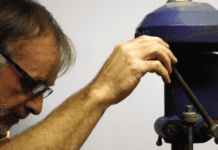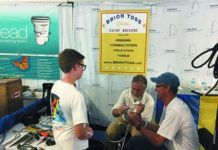As readers know, a tradition at Practical Sailor is, on a single Gregorian cycle, the selection of the Gear of the Year.
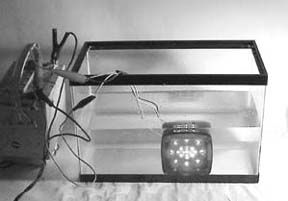
The staff winnows down those products that have appeared in the year’s issues of PS and selects those that have projected a clear superiority and innovation, as well as practical value. Note how “practical” slips in there.
In no specific order or rank, here are products that were distinctive among their kind in the 2003 issues of PS. Phone numbers and Web addresses of the makers of these especially good products appear at the end of this article. Consider it the Honor Roll.
LED Lights
Somewhat startling (even to us) was the appearance in no less that three 2003 issues of shining products based on light-emitting diodes, or LEDs.
As hard as it is to stay on top of all the gear that gets put aboard boats these days, this is a trend we’ve been watching, and maybe even doing our part to create, for quite a while, thus putting ourselves in the ballpark with the late Linus Pauling (who knew what was up with atomic radiation and Vitamin C); England’s amazing Stephen Hawking (who knows about Black Holes) and TV’s Ozzie Osbourne (who must know something, or he wouldn’t be there).
PS’s first report on LEDs was in a 1997 issue. We were tipped off by a reader, Rob Hoffman, a confessed techo-putterer. The report was an explanation of how LEDs work (they’re just forward-biased p-n junctions), and why they are so vastly superior to filament bulbs (power hungry, fragile, short-lived); halogen bulbs (dangerously hot, expensive to make), and fluorescents (which never have won the hearts and minds of anybody).
In the ensuing years, we tracked LEDs in articles in five subsequent issues as they were improved and adapted for use for anchor lights, navigation lights, and flashlights.
“The Revolution in Low-Powered, Long-Lived Lighting” ran in the Jan. 1 issue this year. It was a review of onboard uses for the rugged LEDs.
The October 15 issue was highlighted by a test of 11 LED flashlights. PS liked all of them. But the maximum light intensity winner was the Surefire L4. The top guns for best beam quality (which included the greatest light intensity per unit of weight) were three Surefire models and Tektite’s Expedition Star. The Best Buy tag was affixed to the Surefire L1 and the Tektite Expedition Star.
After all that, the LED popped up yet again in a November 15 Chandlery column item. The report was entitled, “Your Last Set of Trailer Lights?” The subject was SeaSense’s Road Warrior, a well-named product if ever there was one. Although we don’t usually go berserk, the clip-on trailer lights invited mayhem with a label that promised 100,000 hours of life, 100% submersibility and a 10-year warranty. Now, that’s asking for it. We drowned it for a week, turned it on and off underwater, drilled holes in the housing and allowed it to fill with water; ran it on a vibrating table for four hours, and finally, tied it to a car’s bumper and dragged it around. It never even hiccuped.
The consistent, persistent Road Warrior costs $70, but earned PS’s wholehearted endorsement.
Flamestop
Equally surprising was a new product detailed in another Chandlery column report in the July 1 issue. Called Flamestop, it’s a pressurized, water-based surfactant in a conventionally sized can.
The contents amount to but 15 ounces of liquid—but that’s neither here nor there. What’s important is how long the spray lasts. The manufacturer claims a spray time of 30 seconds, but PS’s tests yielded times between 17 and 28 seconds.
Nevertheless, Flamestop worked very well on grease and wood fires. It quickly and effectively extinguished the flames and the pinkish stream was easy to direct. Unlike with dry chemical extinguishers, Flamestop’s mess is easy to clean up with soap and water.
PS concluded, “We don’t recommend Flamestop as a replacement for a more conventional extinguisher,” but certainly endorsed the idea of having a can or two aboard. It’s not at all intimidating to use (one of its best features), and might be a worthwhile response to an event that is best negated by quick, cool, deliberate action.
Flamestop has a $14.95 MSRP. It comes with no mounting bracket, but reader Zel Canter of Solvang, CA, advised in the October 15 Mailport that a plastic bicycle water bottle bracket ($5) will do nicely. You’ll still end up spending a bit less than you would for a spare 5-B:C two-pound dry chemical Kidde Compact, which does comes complete with a bracket.
Chartplotters and EPIRBs
On the electronics front, in the April 15 and July 15 issues respectively, PS tested and reported on GPS Chartplotters and 406 MHz EPIRBS.
For the chartplotters, PS mounted 10 units on a vertical board (no small bit of simple labor). The 10 included two Garmins, two Standard Horizon models, and single models from Furuno, Navman, Si-Tex, Raymarine, Northstar, and Simrad. Knowing the electronics field, it wouldn’t surprise us if some of these models aren’t already superseded. We didn’t check. Chickened out.
We ran each one through an 18-point checklist, the results of which were displayed on a large chart. Besides the standard make/model, source, price, and warranty items, the checklist contained specifications like maximum current draw, GPS channels, screen resolution, construction and whether a unit came with multi-function soft keys.
When the sun went down quite a few days later, PS declared a bit of a toss-up on the smaller models. The Standard Horizon 150C—being handsome, easy to operate, and with a nice price—shaded by a slight margin the Si-Tex Nautilus and the Garmin 182C.
For a stand-alone unit in larger models, PS’s choice was the Simrad CP3, with the Furuno close behind.
Garmin’s BlueChart won plaudits for being, in our view, the best vector software.
Shifting now to the Emergency Position-Indicating Radio Beacons, we lined up five of what now are simply called 406 MHz EPIRBS.
The five are ACR’s Global Fix 406 and Satellite 2 406; the SOS Precision 406 GPS and SOS Rescue 406, both offered by McMurdo Pains Wessex, and Northern Airborne Technology’s Satfind 406 Pro.
These expensive but reassuring electronic signaling devices, some of which now come in models that incorporate GPS, are found—or surely should be—on most offshore boats.
The last time we reviewed EPIRBs was four years ago. The price of the best unit was about $2,000. They have been continually refined since then. As with all electronic equipment whose prices drop drastically in the introductory, developmental years, EPIRBs sell today for half those 1999 prices.
Our view is that when shopping for that ultimate last-ditch mayday, you should go for the GPS option. And our top pick was the ACR Global Fix 406, which, unfortunately is the most expensive.
If you must cut the EPIRB into a very tight budget, we’d take Northern Airborne’s Satfind 406 Pro. It doesn’t have the GPS feature, of course. But it does have a desirable user-changeable battery and that makes it more desirable than the two other “no-GPS” models.
Manual or automatic release features? It’s a $200 extra. Your choice.
7×50 Binoculars
Over the years, PS has assessed binoculars of all kinds. They’re certainly among the most vital of a mariner’s gear. In 2003, we again did 7×50 compass-bearing models, with further criteria being waterproofness and integral bearing compasses. The report was in the August. 1 issue.
Eight models, with a wide price range of $165 to $900, were subjected to a lot of eyeball time. They were the Bushnell Marine, Celestron Nautica, Fujinon FMTRC-SX, Nikon OceanPro, Steiner Commander V, Swift Sea King, Tasco Offshore 54, and West Marine Tahiti.
The basic test was for optical acuity, looking at type targets (for crispness)—much the same as what happens at the ophthalmologist’s office. The testers worked in several locations, to provide varying conditions.
In some phases, the binoculars were hand-held, in another a bench rest was utilized.
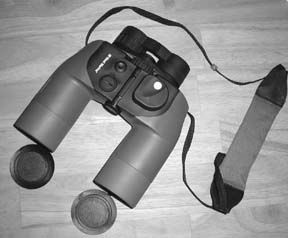
To be thorough, we looked in both good and bad lighting, across flat water, into the sun, and, for our very own reality show, at nuns and cans running out a long channel, which provided excellent distance checks.
The 10 sets also got ease-of-use ratings and close comparisons of their diopter adjustments, protective caps, eyeglass accommodation, user interface with the compass feature, weight, straps, and cases.
One of the unique tests was called the “Transparency Factor,” which means how well a binocular “gets out of the way” and puts you in the scene… sort of like the way a good movie draws you in and makes you forget you’re sitting in a theater.
There were no clearly superior or inferior models for pure optical acuity, but the four that rated Excellent were the Steiner Commander V, West Marine Tahiti, Nikon OceanPro, and Fujinon FMTRC-SX. If low cost is cranked into that excellent category, the Best Buys are the West Marine Tahiti and the Nikon OceanPro, which sell for less than half of either the Steiners or Fujinons.
Foul-Weather Jackets
Now that you can see, how about keeping dry? The report is in the July 15 issue.
We turned the torrents on a dozen foul weather jackets, some with names you may never have heard of, other with familiar, sometimes jawbreaker names. Included were jackets named Coastal, Chapin Passage, Henri Lloyd Rapid Coaster, Musto MPX Gore-Tex Coastal, Gill Key West, Gill Coast, Gill Atlantic, Ronstan Inshore, Helly Hansen Voyage, Offshore, West Marine Explorer and Boat U.S. Hurricane.
A few are intended for offshore work; the rest are in the “coastal” category.
All were rigorously tested for how easy they were to don and, more importantly, how comfortable they were. The latter included many bends, stretches, reaches, rotations, and squats. In our view, these factors are important, not just for comfort but also because gear that restricts movement can range from vexing to dangerous.
Then came the water—a three-minute stint in a hard shower followed by another three minutes of exposure to a hose (pressure: 15 pounds) aimed from every direction.
After that came 15 minutes on a treadmill, to produce heavy perspiration. Unevaporated moisture was measured to evaluate the effectiveness of the “breathability” of each jacket’s material.
Finally, the pockets, closures, zippers, linings, and adjustments were examined and compared.
The PS choice of coastal jackets (which most of us use) was the Henri Lloyd Rapid Coastal. The runner-up was Ronstan’s Inshore, which at $150 less than the Henri Lloyd Rapid Coastal was the Best Buy.
The choice among the generally heavier and very pricy offshore jackets was the Gill Atlantic. It has a $350 price tag… and that might contribute in a very small way to keeping us within sight of land.
Chart Kits
Now that we can see and stay dry, how about where we’re going?
For that, a chart kit is ideal, and very thrifty—compared with the price of the charts printed by Uncle Sam, whose reach into our pockets seems to grow like zucchini. At nearly $20 a pop, a set of government charts for a simple two-week vacation cruise can sting.
Our attempt to encircle the subject of chart kits took up a lot of time (we enjoyed every minute of it) and effort to examine the vast array of chart kits now being offered.
The competition in this field (especially between responsible companies like Maptech and Richardsons) is of inestimable benefit to sailors everywhere. The quality improves with almost every edition. It once was that you could find a few errors, but that seems to be long gone.
PS couldn’t look at them all, and for that (although we stated as much right up front), we caught a bit of scolding from readers with favorites.
But we did what seem to be the major ones. Included were all the Maptech products… Chartkit Books, Compacts, Waterproof Books, and Embassy Guides; and Richardson’s Chartbooks and Waterproof Chartbooks. Others were from Lakeland Boating, Caribbean Yachting Charts (CYC), Imray-Iolaire charts, Yachtsman Chartbooks (a.k.a. Mariner’s Ink), Marine Atlas, Charlie’s Charts, and Explorer Chartbook.
We charted these products, for prices, sizes, formats, harbor inserts, aerial photos, waypoints, advertisements, and areas covered… and added our comments about each, in a report in the May 15 issue.
But when we finally reluctantly gave up poring over these charts, the Bottom Line turned out to be a recommendation that you visit or write to a bookstore/chandlery that specializes in equipping sailors in a particular area with the particular literature to sustain them. We listed a bunch of such sources at the end of that article and were again scolded later for missing others).
Freshwater Pumps
Among the more important pieces of machinery aboard any cruising boat is the freshwater pump. PS has tested the electric variety before, but because there are some very new ones, we did it again in the June double issue.
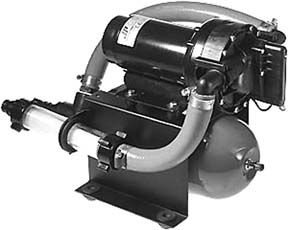
We gathered up 14 of them, all the way from several costing nearly $500 down to some for less than $100. We even tried (unsuccessfully) to run-to-destruction an intriguing little inline pump from Whale, the renowned Irish pumpmaker.
The pumps bore such names as Groco, Johnson, Flojet, Raritan, Shurflo, Par, and Whale.
All 14 models were tested, compared, ranked, and charted for price, gallons-per-minute, amps, decibels, wiring, and types of ports. In the last category the new quick-connect fittings (which make excellent use of O-rings) were a big plus.
Some produced lots of water—and lots of noise. Some pumped more water per amp than others. Six of the 14 had bare copper wiring, which PS definitely regards as inferior to tinned wire.
Depending on your requirements (and how long you might expect a pump to last), there are many choices to make in pumps. You’re faced with choosing among conflicts. Increase the power, and up goes the flow and the noise and amps. Cutting the noise means a smaller, quieter motor, fewer amps…and less water flow.
When PS elected to meld flow, noise, and power consumed, the winner was the Swedish-made Johnson Aqua Jet Uno 3.4, an all-plastic pump (not cheap, at $450) that was the quietest, came in third for lower power consumption, and fifth for water volume.
Next were (#2) the Flojet 3.7 Sensor VSD, one of the new “smart” pumps with automatically variable speeds, (#3) the new-last-year Flojet Quad II, which has an internal bypass valve that serves as an accumulator tank, (#4) the very new Shurflo Extreme Series Smart Sensor, which is similar to the Flojet, and (#5) the Johnson Aqua Jet 5.0.
4-Hp Four-Stroke Outboards
In the March issue, PS did a data-specs-price review of 30 outboard engines in the 4- to 9.9-horsepower range. It made for a big chart showing, among 28 features, engine’s weight; manual or electric start options; shaft lengths available; shifter locations; alarms; fuel and oil capacity; warranty, etc.
Formidable though the chart was, we felt that more was needed to help buyers make a selection that suits their particular purpose.
In that end, we began testing small outboards. (Doing all of them at once would have been a logistical nightmare, and probably impossible anyway. A group at a time seemed preferable.)
To that end, we selected three four-horsepower engines—a Mercury 4M, a Suzuki DF 4, and a Yamaha F4—and put them through their paces.
Each was mounted on an inflatable test boat (noting how it was to carry, handle, and lock on), checked for oil and fuel; started (again recording the degree of difficulty); run for the recommended break-in period; subjected to a few short bursts of full throttle, and, finally, tested for performance and noise.
Further examinations were of the cover, cover latches, throttle locks, tilt mechanisms, spark plug access, and vibration at idle.
Because all three engines had their strong and weak points, a system or prioritization was developed, with the emphasis on operational aspects, ahead of portability and a few other features.
When finished, the testing ranked the Suzuki DF 4 first, the Mercury a close second, and the Yahama third. The report is in this issue, starting on page 33.
We’ll keep testing four-stroke engines, group by group.
Rope Shackles
Finally, here are some of our favorites, from a report in the January 15 issue. You’d never know from their names just what they are. In fact, even when you hold one in your hand, your reaction could be “Whazzit?”
They’re shackles, ferociously strong fittings made of high-tech rope, usually with double-groove spools to secure them. These lightweight replacements for the bronze, stainless, or aluminum shackles scattered about a boat are made possible by the fast-paced development of UHMW-PE fibers, better known by trade names like Dyneema, Spectra, Zylon, and whatever’s new next week.
The fibers are so blasted strong that a small bundle of them is stronger than the aforementioned metals, and far lighter. Further, they’ve shed, just in the last several years, the earlier liabilities of not liking to be bent and a proneness to abrasion.
PS has carried many reports of rope made from these amazing fibers. Now it’s shackles.
Yale Cordage calls its version a Yale Loup. Aramid Rigging, in Portsmouth, RI, calls its a LoopIt. A restless engineer/inventor in Australia, Don Churchod, calls his EquipLites. Hall Spars is his U.S. distributor.
It’s difficult to explain how they work. Basically, they’re just rope loops (which in the Manila Era were known as grommets), one end of which is secured in the hole in a spool, with the other end looping back to engage a groove in the spool body.
That’s it. Easy to make. Cheap. Light. Strong.
Now, we turn over a leaf on Gregory’s calendar, put 2004 on the front cover, and get back to work.
Contacts
• Aramid Rigging, 401/683-6966, www.aramidrigging.com
• Fujinon, 973/633-5600, www.fujinon.co.jp
• Furuno USA, 360/834-9300, www.furuno.com
• Flamestop, 866/909-6525, www.allamericansafety.com
• Flojet, 949/859-4945, www.flojet.com
• Garmin, 913/397-8200, www.garmin.com
• Gill, 770/945-0564, www.gillna.com
• Hall Spars, 401/253-4858, www.hallspars.com
• Henri Lloyd, 800/661-5696, www.henrilloyd.com
• Nikon, 800/247-3464, www.nikonusa.com
• Johnson, 847/671-7867, www.johnson-pump.com
• Ronstan, 727/545-1911, www.ronstan.com/marine
• SeaSense, 800/282-8725, www.seasense.com
• Shurflo, 800/854-3218, www.shurflo.com
• Simrad, 425/778-8821, www.simradusa.com
• Si-Tex, 727/576-5734, www.si-tex.com
• Standard Horizon, 714/827-7600, www.standardhorizon.com
• Steiner (Pioneer Research), 856/866-9191, www.steiner-binoculars.com
• SureFire, 800/828-8809, www.surefire.com
• Suzuki, 714/996-7040, www.suzukimarine.com
• Tektite Industries, 800/540-2814, www.tek-tite.com
• West Marine, 800/262-8464, www.westmarine.com
• Yale, 207/282-3396, www.yalecordage.com






























